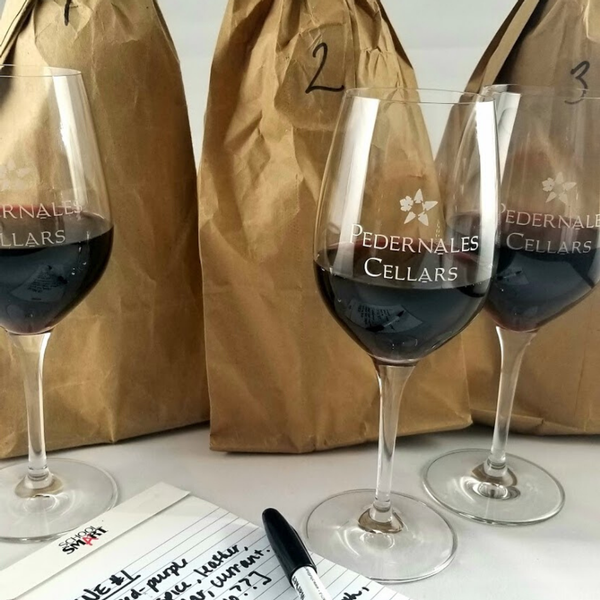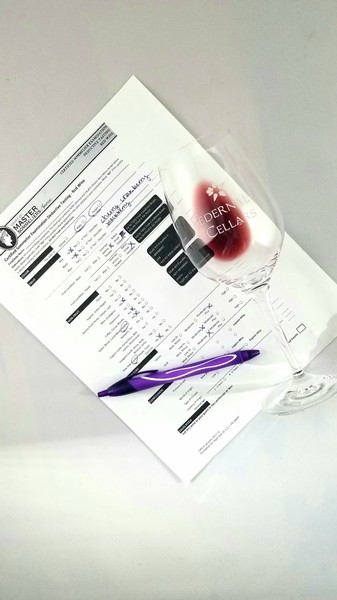How to host a blind wine tasting party with friends

If you are feeling like you’re in an entertaining rut with your friends, we recommend shaking up the normal routine of cheese, wine, and charcuterie for a blind tasting among friends. Blind tastings are a great way to initiate a thoughtful discussion about the wines you enjoy and trying wines without knowing what they are challenges everyone to take time to appreciate and evaluate each sip with intention.
So, what is a blind tasting?. In a blind tasting, you conceal information (ie: the label and bottle) that may influence the tasters’ opinion on the wine itself. While tasting each wine, everyone writes down notes about color, aromas, flavors, and any other details they notice. With this style of tasting, you may be surprised by what you learn about your own tastes as well as your friends’ preferences too. Here are our top three tips for hosting a successful blind tasting party with your friends.
1. Gather the supplies.
Notebooks or cards for tasting notes and pens are a must. This is how you and your guests can keep track of your thoughts and initial impressions of each wine for later review. Stock plenty of clean and polished glasses, ensure there are enough spittoons around the table and have some snacks available.
Determine how you will mask your bottles - paper bags, foil, gift wrap, anything goes so long as you and your guests will be unable to determine the wine by looking at the bottle. Remove foil capsules and be sure that you mask the bottle shape if it’s a giveaway. Have different corks or bottle stoppers available that won’t give away the identity of each wine. Last but not least, pick the wine list then separate the reds and whites - mask, number, and prep them for service.
If you and your friends are new to wine descriptors you may consider printing out a few resources such as the Wine and Spirits Education Trust (WSET) systematic approach to tasting or the Court of Master Sommeliers deductive tasting grid to help guide the process.

2. Determine your food and wine menu.
This is where you can let those charcuterie board building skills shine. You may not think you need food for a wine tasting, but it’s a very good idea to have food when you are going to be drinking a higher ABV beverage like wine. Not all of your guests will be spitting out their tastes of wine, so having food will help to absorb some of the alcohol.
Salty foods have an interesting effect on the palate acting almost like a reset button. Bear in mind that the food you select should not overpower the wines, but rather serve to keep your guests satisfied. Be sure to select a variety of starchy, cheesy, briney, fresh fruit and veggies for color and texture. Finally, add a few salty items that will pair well with an array of wines and satisfy diverse palates.
When selecting the wines for your blind tasting, we recommend having something among them that is common like the varietal or the appellation of origin. Or if you want to take a deep dive into a region or producer, go “vertical” and see if you and your guests list the wines in the blind tasting in order of vintage year from oldest to youngest.
Our wine club manager recommends trying either a white or red wine lineup. Try a Pedernales Cellars white wine varietal blind tasting selection of:
See if your guests can figure out which white varietal is in the glass. Or, if you have guests with advanced tasting skills try something more difficult like this Tempranillo based lineup:
3. Consider your setting.
When tasting wine, your setting can influence your perception quite a bit. It may seem obvious, but when closely evaluating a wine, more light helps guests to examine the color of their wines.
When hosting a blind tasting at home resist the urge to burn your favorite candles, incense, or wear heavy perfumes as all of these have a significant impact on the olfactory experience. “Nosing” a glass of wine is a fantastic way to narrow down the potential varietal, region, or vintage year so be sure not to compromise your guests’ ability to appreciate the aromatic nuances of their wine.
As the host, it is also your job to keep the blind tasting moving in an efficient and somewhat organized fashion. This can become difficult when you’re among friends (especially as you sample many wines) so do not get too uptight about it if your blind tasting party evolves - just be prepared to tactfully refocus everyone if it becomes necessary. If you are really worried about it, consider narrowing the menu to only three wines so there is more room for chatting between each tasting.
Remember rule number one of a wine tasting party. Have Fun!
When hosting a blind wine tasting party with friends, always remember the goal is to have fun and enjoy good wine and your company! Take the time to savor the experience, appreciate the wine, and get to know a little more about your friends’ tastes in the process.